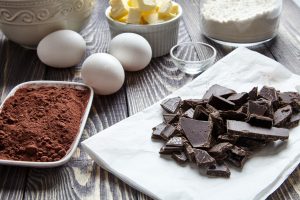“ocoa butter melts very quickly at a temperature that is about the same as the temperature of a human body. This means that when you are using cocoa butter when baking a product, you will not get an intermediate stage when the cocoa butter is semi-soft or about to melt.
This is also the reason why chocolate has such a high pleasure factor for humans: it melts almost immediately after it touches the tongue. Cocoa butter is what makes chocolate so delicious, but at the same time, it is exactly what makes chocolate hard to work with when it comes to using it during the baking process.
such a high pleasure factor for humans: it melts almost immediately after it touches the tongue. Cocoa butter is what makes chocolate so delicious, but at the same time, it is exactly what makes chocolate hard to work with when it comes to using it during the baking process.
Cocoa butter consists of four different types of crystals. These crystals are alpha, beta, beta prime, and gamma. The crystals melt at 70-75F, 95F, 81-84F and 63F accordingly. Only one type of crystals is stable and results in a shiny, solid chocolate coating or a standalone piece of chocolate. This type of crystals is the beta crystal.
You can melt the chocolate in a bath of hot water, in a boiler or even in a microwave. Cocoa butter separates from the cocoa solids at around 120F. If you want to prevent chocolate from seizing, you need to add 1.5 teaspoons of liquid per ounce of chocolate.
If you want to temper chocolate, you will need a precise thermometer. There are special chocolate thermometers available that have been created for bakers. Such thermometers typically have a range between 80F and 130F. Experienced bakers usually get to the point where they can determine the temperature of chocolate by using their wrist or upper lip, but not by using their fingertips because most seasoned bakers lose heat sensitivity in fingertips due to a large amount of small repeated finger burns.
